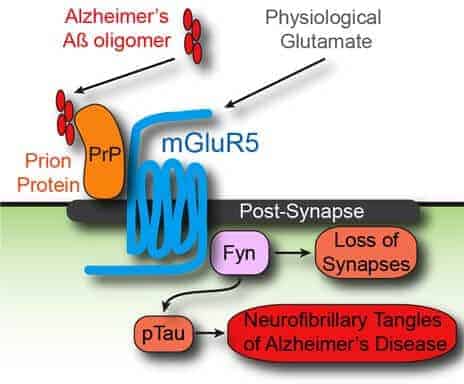Yale School of Medicine researchers have discovered a protein that is the missing link in the complicated chain of events that lead to Alzheimer’s disease, they report in the Sept. 4 issue of the journal Neuron. Researchers also found that blocking the protein with an existing drug can restore memory in mice with brain damage that mimics the disease.
“What is very exciting is that of all the links in this molecular chain, this is the protein that may be most easily targeted by drugs,” said Stephen Strittmatter, the Vincent Coates Professor of Neurology and senior author of the study. “This gives us strong hope that we can find a drug that will work to lessen the burden of Alzheimer’s.”
Scientists have already provided a partial molecular map of how Alzheimer’s disease destroys brain cells. In earlier work, Strittmatter’s lab showed that the amyloid-beta peptides, which are a hallmark of Alzheimer’s, couple with prion proteins on the surface of neurons. By an unknown process, the coupling activates a molecular messenger within the cell called Fyn.
In the Neuron paper, the Yale team reveals the missing link in the chain, a protein within the cell membrane called metabotropic glutamate receptor 5 or mGluR5. When the protein is blocked by a drug similar to one being developed for Fragile X syndrome, the deficits in memory, learning, and synapse density were restored in a mouse model of Alzheimer’s.
Strittmatter stressed that new drugs may have to be designed to precisely target the amyloid-prion disruption of mGluR5 in human cases of Alzheimer’s and said his lab is exploring new ways to achieve this.
Other Yale authors are Ji Won Um, Adam C. Kaufman, Mikhail Kostylev, Jacqueline K. Heiss, Massimiliano Stagi, Hideyuki Takahashi, Meghan E. Kerrisk, Alexander Vortmeyer, Thomas Wisniewski, Anthony J. Koleske, Erik C. Gunther and Haakon B. Nygaard.
The research was funded by the National Institutes of Health.


